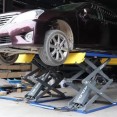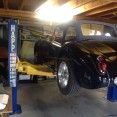This page indicates requirements for safe operation of your HAPP product.
It may seem a little detailed at first glance but its important you read and understand this to avoid problems later on. Undersanding this information will give you more confidence in your work environment being a safe place for you and others.
What is a ‘Competent Person’ ?
HAPP documents and Australian Standards refer to a “Competent Person”, this term is defined in AS/NZS 1418.1-1.4.1 as ‘person who has acquired through training, qualification, experience or a combination of these, the knowledge and skill enabling that person to correctly perform the required task’.
What does this mean to you our customer? It means that a competent person must have knowledge of the relevant standards and the knowledge and skills in the area you engage them for.
When do i need a competent person?
HAPP products must be installed / signed off , inspected by a competent person prior to use in any workshop, a competent person is also required to perform / sign off any scheduled maintence checks required by HAPP or regulations.
The competent person should be aware of the relevant Australian Standards that are specified for that area. For example AS/NZS 1418.1 / AS/NZS 1418.9 and supporting standards for vehicle hoists and AS/NZS 3000 for electrical connections and be familiar with WH&S codes of practice in the area you are located (referenced below).
In relation to HAPP hoist products competent people resolve and sign off on the physical condition of product (any production issues and installation pre-requisites according to manufacturers requirements) , installation (site issues such as those specified in the relevant safe work code of practice and HAPP manuals), electrical connections and operation of the product (according to manufacturers operations, maintenance requirements) which typically involves some training component.
Who needs standards and practices?
The requirements outlined above are mandatory for business premises by workplace health and safety and HAPP warranty. They are required for home users for HAPP warranty purposes and possibly for your insurance company. It is your responsibility to ensure you engage competent person(s) to perform your installation and training on the operation of your product. It is required that competent persons utilise (fill out) the HAPP maintenance manuals as a minimumum for ongoing operational checks, scheduled maintenance checks and engage competent persons to review the hoist for items listed in our manuals at least on a yearly basis. They should also ensure that no breaches of the safe work code of practice have occurred since the last inspection.
You and the competent person engaged are required to have fully followed the installation instructions for the product, followed all operations and maintenance directives, and have followed the code of practice provided by Safe Work Australia and Workplace Health and Safety in the state you are located.
Businesses are required to have a full inspection of the machine every 12 months by a competent person, this is recommended for home users as well. Limited use of a hoist is not a reason to avoid this inspection.
What is the workplace code of practice ?
The site code of practice is the code to manage risks of plant in the workplace across the entire work site. There are many areas that persons conducting businesses or managing a business must follow to minimise risk, avoid incidents. HAPP strongly recommends you review the relevant workplace code of practice and ensure you have all risks addressed / minimised.
These codes don’t cover every risk which may arise. It’s best for you to consider all hazards connected to your work, not only those that are regulated. If you’re a duty holder, you can use another method to meet your legal duties. But you need to make sure your approach gives the same or a higher standard of work health and safety than the relevant code of practice.
The Safe Work Australia publication is available at https://www.safeworkaustralia.gov.au/doc/model-codes-practice/model-code-practice-managing-risks-plant-workplace/>
For Queensland. Managing the risks of plant in the workplace, Code of Practice. Workplace Health and Safety Queensland (WHSQ).
https://www.worksafe.qld.gov.au/laws-and-compliance/codes-of-practice
For other states search on “Managing the risks of plant in the workplace, Code of Practice” followed by your state name.
Featured Products
 HAPP12: 3T full height scissor lift, WH&S app SAVE $1k! Now $4990
HAPP12: 3T full height scissor lift, WH&S app SAVE $1k! Now $4990 HAPP25: 4T Four Post, 2000mm lift, approved by WH&S – SALE $3800 WOW!
HAPP25: 4T Four Post, 2000mm lift, approved by WH&S – SALE $3800 WOW! HAPP30P: 4T 2 post floor hoist, 1.9m lift, WH&S approved – SALE $3290
HAPP30P: 4T 2 post floor hoist, 1.9m lift, WH&S approved – SALE $3290 HAPP90: 2 post electric – hydraulic lift, free standing hoist, Adjustable width – SALE $3300 + FREE seat or parts carrier!!
HAPP90: 2 post electric – hydraulic lift, free standing hoist, Adjustable width – SALE $3300 + FREE seat or parts carrier!!